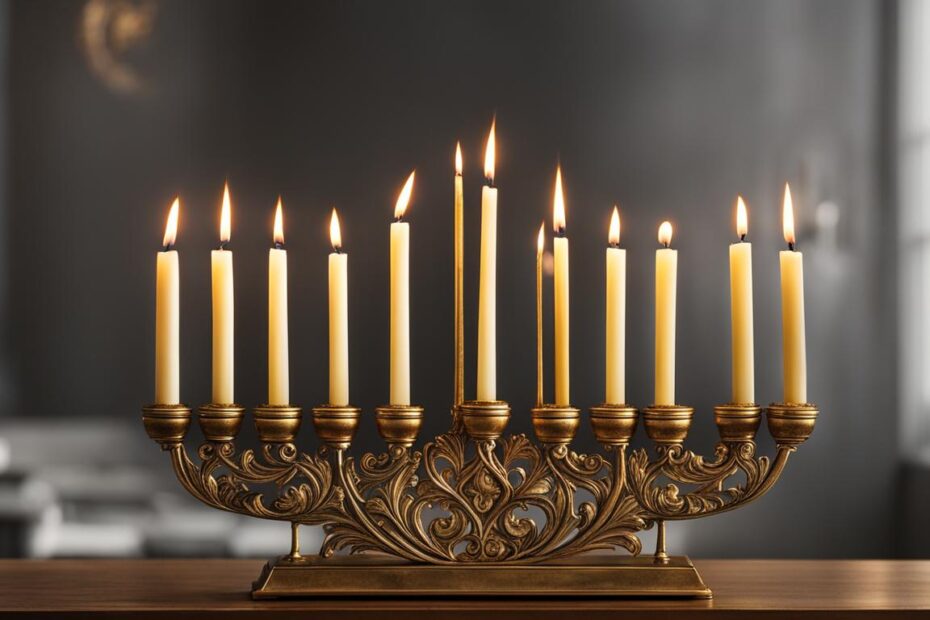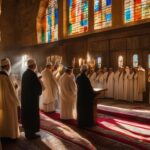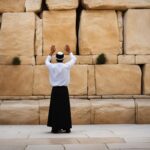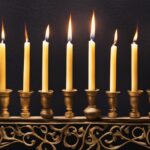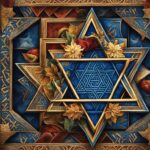The menorah holds a deep historical and symbolic significance in Jewish tradition. It is a multibranched candelabra used in the religious rituals of Judaism, particularly during the festival of Hanukkah. With its roots dating back to ancient times, the menorah has evolved over the centuries, representing the rich cultural heritage and enduring strength of the Jewish people.
The menorah’s historical significance can be traced back to the wilderness sanctuary and later the Temple in Jerusalem. Originally a seven-branched candelabra, it was a popular motif in religious art in antiquity. Today, an eight-branched menorah is used by Jews during Hanukkah, a holiday that celebrates the rededication of the Second Temple.
The menorah represents more than just a religious artifact. It is a symbol of Israel, embodying the idea that it is to be a “light unto the nations.” The menorah signifies the importance of peaceful and enlightened actions, reflecting the Prophet Zechariah’s vision that Israel’s mission would be achieved through the spirit rather than through might or power.
Throughout history, the menorah has taken on different forms and variations. While the traditional seven-branched menorah is the most well-known, there are also nine-branched menorahs used during Hanukkah, as well as unique designs and artistic interpretations that showcase the creativity and individuality of artists.
Menorahs can be crafted from various materials, including olive wood and metal. Olive wood holds significance in Jewish culture due to its association with olive oil, which was used to light the Temple menorah. Metal menorahs provide durability and offer a wide range of design options. In modern times, menorahs can be made from materials such as glass, ceramic, and even recyclable materials.
The menorah’s usage is primarily associated with Hanukkah, where it is lit each night for the eight days of the festival. The lighting of the menorah is accompanied by prayers and blessings, creating a festive atmosphere that brings families together to celebrate this joyous holiday.
Key Takeaways:
- The menorah is a multibranched candelabra used in Jewish religious rituals, particularly during Hanukkah.
- The menorah represents the rich cultural heritage and enduring strength of the Jewish people.
- It symbolizes the idea of Israel being a “light unto the nations” and emphasizes the importance of peaceful and enlightened actions.
- There are variations of menorahs, including the traditional seven-branched menorah and the nine-branched menorah used during Hanukkah.
- Menorahs can be crafted from materials such as olive wood, metal, glass, ceramic, and even recyclable materials.
Origins of the Menorah in Jewish Tradition
The Jewish Menorah is deeply rooted in biblical origins and has played a significant role in Jewish religious practices throughout history. The first mention of the Menorah can be found in Exodus: Chapter 25, where instructions were given on how to construct the sacred lampstand. It was built and lit in the Temples by priests during evening services.
The Menorah consisted of seven branches, representing the design originally found in the Temple. Each branch held a wick and was filled with olive oil, which symbolized the light and presence of God. The wicks and olive oil were replaced every morning to ensure the continuous illumination of the Menorah.
After the destruction of the Temples, the Jewish Menorah was no longer made due to fear of persecution. However, new designs with one fewer candle were crafted to replace the original seven-branched Menorah. Today, some rabbis have reintroduced the traditional seven-branched design, while others continue to use the modified versions.
The Jewish Menorah in Practice
The Menorah holds immense symbolic significance in Jewish tradition. It represents the light of God and is a reminder of the role of Israel as a “light unto the nations.” The lighting of the Menorah during Hanukkah is a central part of the holiday celebration, symbolizing the miracle of the oil that lasted eight days.
To this day, Jewish communities and individuals gather each night of Hanukkah to light the Menorah. The candles are inserted from right to left, but they are lighted from left to right. The Menorah lighting is accompanied by prayers and blessings, creating a meaningful and festive atmosphere.
| Materials Used for Menorahs | Symbolism and Variations |
|---|---|
| Olive wood | Significance in Jewish culture and association with olive oil |
| Metal | Durability and design flexibility |
| Glass, ceramic, recyclable materials | Modern adaptations and personal preferences |
“The Menorah is a powerful symbol that represents the light of God and the mission of Israel to spread enlightenment to the world.”
The Menorah has undergone changes over time, adapting to historical and cultural shifts within Judaism. It has served as a prominent motif in ancient art and has transitioned from the Star of David to ultimately becoming the symbol of the Zionist movement and the emblem of the state of Israel.
While the seven-branched and nine-branched Menorahs are the most well-known, there are lesser-known variations that showcase artistic interpretations and unique designs. These variations add diversity to the symbolism and aesthetics associated with the Menorah, allowing for personal expression and creativity.
Overall, the Menorah’s origins in Jewish tradition, its usage in practice, and the materials and variations associated with its design reflect the rich history and profound symbolism that the Menorah holds within the Jewish community.
Symbolism of the Menorah
The menorah holds deep symbolism within Jewish tradition and is regarded as a powerful representation of the nation of Israel. It embodies the concept of being a “light unto the nations,” signifying Israel’s mission to spread enlightenment and wisdom to the world. This symbolism is rooted in the teachings of the Prophet Zechariah, who had a vision of a menorah and was told by God that Israel’s mission would not be accomplished through might or power, but through the spirit.
The menorah’s significance lies in its emphasis on peaceful and enlightened actions. It serves as a reminder that Israel’s mission is to set an example and inspire others through its actions rather than through force. The menorah reflects the importance of kindness, compassion, and understanding as guiding principles in Jewish philosophy and serves as a visual representation of these ideals.
The menorah is a peaceful force, symbolizing the role of Israel in spreading light, knowledge, and understanding to the world.
Furthermore, the menorah is recognized as a symbol of the resilience and endurance of the Jewish people. Throughout history, the Jewish community has faced numerous challenges and adversities, yet they have continued to persevere. The menorah serves as a reminder of the strength and determination of the Jewish people and their ability to overcome obstacles with faith and perseverance.
| Symbolism of the Menorah | Keywords |
|---|---|
| Represents the nation of Israel | Symbol of Israel |
| Signifies being a “light unto the nations” | Light unto the nations |
| Emphasizes peaceful and enlightened actions | Peaceful force, significance |
| Reflects the resilience and endurance of the Jewish people | Resilience, significance |
| Represents the importance of kindness, compassion, and understanding | Symbolism, significance |
The symbolism of the menorah extends beyond the Jewish community and holds relevance for individuals of all backgrounds. It serves as a reminder of the power of peaceful actions, the strength of unity, and the importance of spreading light and knowledge in a world that often faces darkness and ignorance.
Variations among Menorahs
The menorah, a symbol deeply rooted in Jewish tradition, has taken on various forms and designs throughout history. While the traditional seven-branched menorah holds significant religious and historical importance, there are other variations that have emerged over time, particularly during the celebration of Hanukkah.
One notable variation is the nine-branched menorah, also known as the Hanukkah menorah or the Hanukkiah. This menorah is specifically used during the eight-day festival of Hanukkah to commemorate the miracle of the oil lasting eight days in the Second Temple. It features eight branches for candles and one additional branch for the shammash, which is used to light the other candles.
Furthermore, there are differences in menorah designs and interpretations based on different Jewish traditions and personal preferences. Some rabbis argue that the seven-branched menorahs used today are not the same as the one used in the Temple and have reintroduced the original design. This has led to the use of both seven-branched and nine-branched menorahs in various Jewish communities.
| Types of Menorahs | Description |
|---|---|
| Seven-Branched Menorah | The traditional menorah with seven branches, symbolizing the original design found in the Temple. |
| Nine-Branched Menorah | Also known as the Hanukkah menorah or Hanukkiah, it is specifically used during the festival of Hanukkah to commemorate the miracle of the oil lasting eight days. |
| Variations in Design | Menorah designs can vary based on different Jewish traditions and personal preferences, including the reintroduction of the original seven-branched design. |
These variations in menorahs highlight the diversity within Jewish culture and the significance placed on the celebration of Hanukkah. While the traditional seven-branched menorah remains a symbol of ancient Jewish history, the nine-branched menorah and other design variations add richness and meaning to the observance of Hanukkah and the Jewish faith as a whole.
Materials Used for Menorahs
Menorahs, the iconic candelabras used in Jewish religious rituals, are crafted from various materials that hold both traditional and modern significance. The choice of material for a menorah can depend on factors such as cultural heritage, personal preference, and intended use. Two commonly used materials for menorahs are olive wood and metal.
Olive Wood
Olive wood is steeped in symbolism and holds special significance in Jewish culture. It is associated with the olive oil that was used to light the original Temple menorah. Menorahs carved from olive wood showcase the natural beauty and grain patterns of this durable and meaningful material. The warmth and rich tones of the wood add a touch of tradition to the menorah, creating a connection to the ancient roots of Jewish heritage.
Metal
Metal is another popular choice for menorahs due to its versatility and ability to be crafted into intricate designs. Menorahs made from metal can range from simple and minimalist to ornate and decorative. Metals such as brass, silver, and pewter are commonly used, offering a wide range of colors and finishes. Metal menorahs are often cherished heirloom pieces, passed down through generations, and can bring an elegant touch to the Hanukkah celebration.
Modern Materials
As times change, so do the materials used for menorahs. In modern times, artisans and craftsmen have embraced innovation, exploring new materials to create unique and contemporary menorah designs. Glass, ceramic, and even recyclable materials are now being used to craft menorahs that reflect personal style and environmental consciousness. These modern menorahs add a fresh and vibrant element to the Hanukkah celebration, blending tradition with contemporary aesthetics.
| Material | Key Features | Symbolic Significance |
|---|---|---|
| Olive Wood | Natural beauty, durability, rich tones | Connection to the ancient roots of Judaism, association with olive oil |
| Metal (brass, silver, pewter) | Versatility, intricate designs, wide range of colors and finishes | Elegance, cherished heirloom pieces, aesthetic appeal |
| Glass, Ceramic, Recyclable materials | Contemporary, innovative, vibrant | Personal style, environmental consciousness, modern aesthetics |
Whether crafted from traditional olive wood or modern materials, the menorah remains a symbol of Jewish tradition and unity. The choice of material for a menorah allows individuals to express their connection to Jewish heritage and personalize their Hanukkah celebration. From the timeless elegance of metal menorahs to the contemporary flair of glass or ceramic designs, the materials used in crafting the menorah reflect the ongoing evolution of Jewish culture and the enduring relevance of this beloved symbol.
Ancient Art and Religious Symbolism of the Menorah
The menorah has a rich history in ancient art and holds deep religious symbolism within Judaism. In ancient times, the menorah was a popular motif in religious art, often depicted in tombs and on synagogue walls and floors. These artistic representations showcased the significance of the menorah as a symbol of Jewish identity and faith. The seven-branched design of the menorah, with its elegant shape and decorative elements, served as a visual reminder of the light and presence of God.
After the destruction of the Second Temple and the disappearance of the Temple menorah, the representation of the menorah transitioned to the Star of David during the early modern period. However, in the 19th century, the menorah regained prominence as the symbol of the Zionists and eventually became the official emblem of the state of Israel in the 20th century. This evolution of the menorah’s representation reflects the cultural and historical changes within Judaism, highlighting its enduring significance as a symbol of Jewish identity and resilience.
“The menorah has been a powerful symbol throughout Jewish history, representing the faith, heritage, and mission of the Jewish people.”
Today, the menorah continues to hold deep religious and cultural significance. It is an emblem of Jewish tradition, reminding individuals of the importance of miracles, faith, and the enduring strength of the Jewish people. The menorah’s representation in ancient art, its transition to the Star of David, and its current status as the emblem of the state of Israel highlight its historical and symbolic importance within Jewish culture.
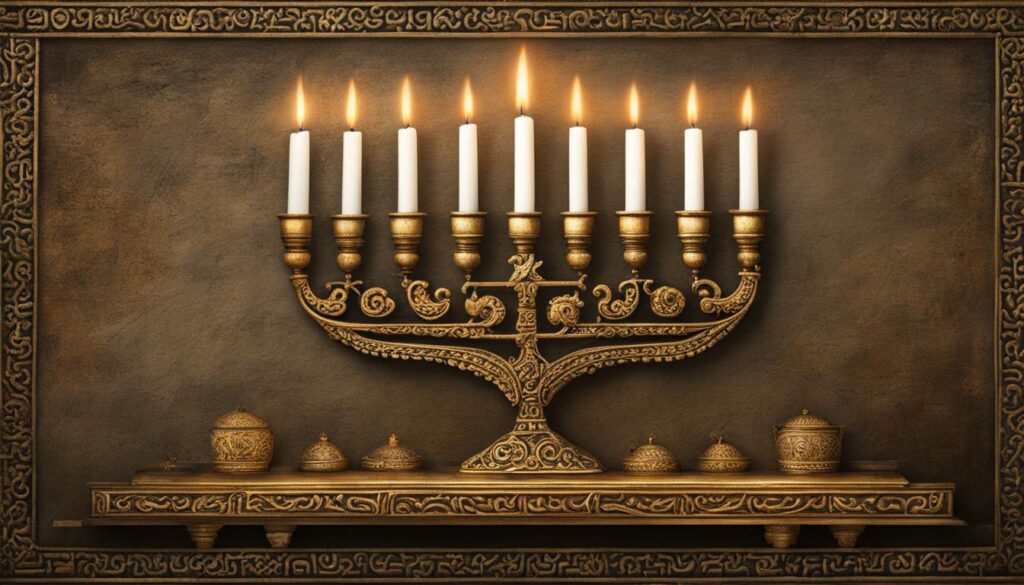
Table
| Evolution of the Menorah | Symbolism | Representation |
|---|---|---|
| Ancient Art | Represents the light and presence of God | Decorated tombs and synagogue walls and floors |
| Disappearance of the Temple Menorah | Transitioned to the Star of David | Early modern period |
| State of Israel Emblem | Symbol of Jewish identity and resilience | Official emblem of the state of Israel in the 20th century |
Lesser-Known Menorah Tools and Variations
While the seven-branched and nine-branched menorahs are the most well-known, there are lesser-known menorah tools and variations that add uniqueness and artistic flair to this ancient symbol. These variations showcase the creativity and individuality of artists, resulting in stunning designs that captivate the eye and evoke a sense of wonder.
“The menorah is not limited to a standard design. Artists have embraced the opportunity to explore different interpretations and create one-of-a-kind menorahs,” says Rabbi David Cohen, an expert in Jewish art history. “From intricate metalwork to carved wood and even unconventional materials, each menorah becomes a work of art, telling its own story.”
Artistic variations of the menorah can incorporate additional elements such as decorative motifs, carvings, or unique shapes. These designs often draw inspiration from Jewish culture, symbolism, or personal experiences. From minimalist modern designs to ornate and traditional styles, there is a wide range of options to suit different tastes and preferences.
Examples of Lesser-Known Menorah Tools and Designs
Table: Lesser-Known Menorah Tools and Designs
| Tool/Design | Description |
|---|---|
| Tree of Life Menorah | A menorah design incorporating the Tree of Life motif, symbolizing growth, wisdom, and connection. |
| Mosaic Menorah | A menorah adorned with intricate mosaic patterns, showcasing the beauty of colorful glass or tile pieces. |
| Travel Menorah | A compact and portable menorah design, perfect for individuals who want to light the menorah while traveling. |
| Music Menorah | A menorah featuring musical instruments, notes, or lyrics, appealing to music lovers and musicians. |
| Abstract Menorah | A unique and unconventional menorah design that explores abstract shapes and forms, offering a modern and artistic interpretation. |
These examples are just a glimpse of the vast array of lesser-known menorah tools and designs available. Each design represents the creativity and imagination of the artists behind them, transforming the menorah into a captivating and personalized piece of art.
Menorah’s Usage in Practice
Menorah lighting is a central element of Hanukkah rituals and plays a significant role in Jewish prayer services and celebrations. The lighting of the menorah takes place each night for the eight days of Hanukkah, symbolizing the miracle of the oil that lasted eight days in the Temple menorah.
During Hanukkah, the candles on the menorah are inserted from right to left, but they are lighted from left to right. The lighting of the candles is often accompanied by prayers and blessings, recited by individuals or led by a religious leader. This practice creates a solemn and sacred environment, invoking a sense of unity and reverence among those participating in the ritual.
Menorah lighting is not only limited to Hanukkah but also holds a significant place in other Jewish prayer services and religious ceremonies. The menorah symbolizes the light and presence of God, and its usage serves as a reminder of the importance of faith, spirituality, and the Jewish heritage. Whether in a synagogue, at home, or in a communal gathering, the menorah is a powerful symbol that brings people together and strengthens their connection to their religious traditions.
Table: Menorah Lighting and Hanukkah Rituals
| Components | Description |
|---|---|
| Menorah | A candelabra with branches or candles used for lighting |
| Eight Candles | Represent the eight days of Hanukkah |
| Shammash | An additional candle used to light the other candles |
| Prayers and Blessings | Recited during the lighting of the candles |
| Left to Right Lighting | Candles are lit from left to right, with the shammash used to light the other candles |
The menorah’s usage in practice varies among different Jewish communities and individuals. While there are common traditions and rituals associated with menorah lighting, there can be slight variations in the specific prayers and blessings recited, as well as the traditions followed during the lighting process. These variations add diversity and personal meaning to the practice, allowing individuals to connect with their spirituality in a way that resonates with them personally.
Overall, the menorah’s usage in practice serves as a reminder of the miracles and triumphs of the Jewish people, the importance of faith, and the enduring strength of the Jewish heritage.
Materials Used for Menorahs
Menorahs, used in Jewish religious rituals and especially during Hanukkah, can be crafted from various materials, each offering unique qualities and aesthetic appeal. Traditional materials commonly used for menorahs include olive wood and metal, while modern menorahs can be made from a wide range of materials such as glass and ceramic.
Olive Wood
Olive wood holds deep significance in Jewish culture and carries a historical connection to the Temple menorah. The association with olive oil, which was used to light the menorah in the Temple, makes olive wood a popular choice for traditional menorahs. The warm tones and natural grain pattern of olive wood create a visually appealing and timeless piece.
Metal
Metal is another common material used for menorahs. It provides durability and allows for intricate designs and decorative embellishments. Menorahs made from metal can range from simple and minimalist designs to ornate and elaborate creations. Metal menorahs offer versatility in terms of style and can be found in various finishes such as brass, silver, or bronze.
Modern Materials
Contemporary menorahs showcase the creativity and innovation of artists and designers who explore unconventional materials. Glass menorahs add a touch of elegance with their transparent and translucent qualities, creating a soft and luminous glow when candles are lit. Ceramic menorahs offer a wide range of colors and artistic expressions, allowing for unique and personalized designs. Additionally, some modern menorahs are crafted from recyclable materials, aligning with eco-conscious values.
When choosing a menorah, the material should be considered based on personal preference, style, and the intended use of the menorah. Whether it’s the timeless beauty of olive wood or the contemporary appeal of glass or ceramic, the material used in a menorah contributes to its overall significance and visual impact.
| Material | Description | Advantages |
|---|---|---|
| Olive Wood | Sustainably sourced wood from olive trees | Significance in Jewish culture Natural warmth and grain pattern |
| Metal | Brass, silver, bronze, or other metals | Durable and long-lasting Allows for intricate designs and embellishments |
| Glass | Transparent or translucent glass | Elegant and luminous when candles are lit Offers a wide range of colors |
| Ceramic | Kiln-fired clay | Artistic expressions and unique designs Wide variety of colors and finishes |
| Recyclable Materials | Eco-friendly materials | Aligns with sustainable values Possibility of unique and creative designs |
Menorah and Hanukkah Celebration
The lighting of the Menorah is a central element of Hanukkah celebrations. Each night, one additional candle is lit, starting with the shammash, which is used to light the other candles. This ritual symbolizes the miracle of the oil that lasted eight days. The Menorah lighting creates a festive atmosphere, and families gather to celebrate this joyous holiday. Hanukkah traditions also include playing dreidel, eating traditional foods like latkes and sufganiyot, and exchanging gifts. The Menorah serves as a focal point for these celebrations, reminding individuals of the importance of miracles, faith, and the resilience of the Jewish people.
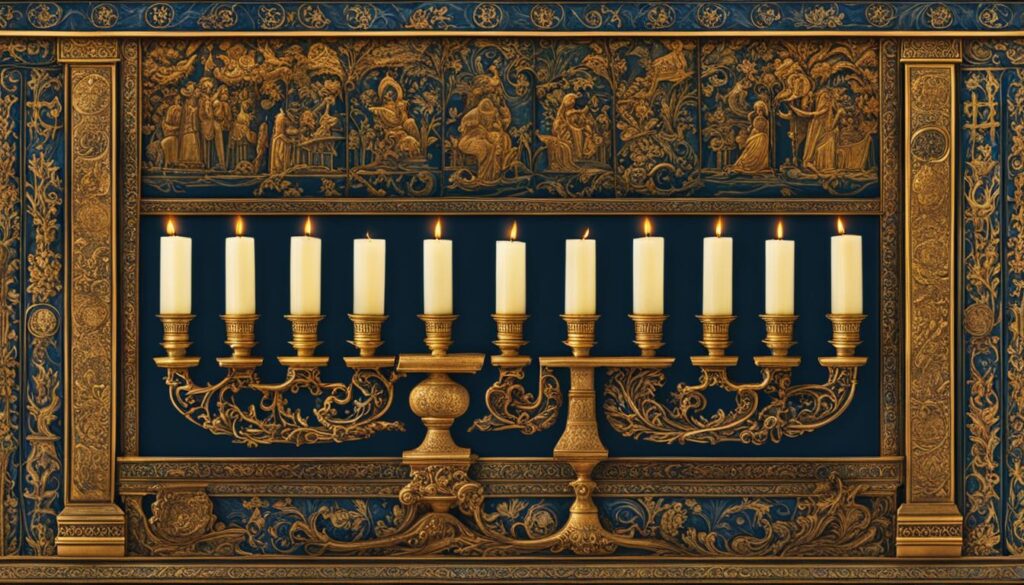
The Menorah’s usage goes beyond the Hanukkah celebration. It holds a significant symbolic meaning in Jewish traditions. The act of lighting the Menorah brings people together, fostering a sense of unity and spiritual connection. It is a time for families to gather, reflect, and express gratitude. The warm glow of the Menorah’s candles illuminates the room, creating an atmosphere of peace and joy. The Menorah is a visual representation of the miracles and blessings that bring light into people’s lives.
The Festive Atmosphere of Menorah Lighting
The Menorah lighting ceremony during Hanukkah evokes a sense of joy and excitement. As each candle is kindled, the room fills with a warm, radiant glow. The Menorah becomes a focal point, drawing attention and creating a festive ambiance. The anticipation builds as the flames dance and flicker, capturing the attention of all those present. The Menorah’s candles symbolize hope, faith, and the triumph of light over darkness.
| No. of Candles | Night | Prayers | Blessings |
|---|---|---|---|
| 1 | First | Light the shammash | Shehecheyanu blessing |
| 2 | Second | Light the shammash and the second candle | Shehecheyanu blessing and the first night candle lighting blessing |
| 3 | Third | Light the shammash and the third candle | Shehecheyanu blessing and the candle lighting blessing |
| … | … | … | … |
| 8 | Eighth | Light the shammash and all eight candles | Shehecheyanu blessing and the candle lighting blessing for the eighth night |
The Menorah lighting brings families together, creating unforgettable memories and strengthening bonds. It is a time to reflect on the miracles of the past and to embrace the hope and joy that Hanukkah represents. The Menorah’s candles illuminate not only physical spaces but also hearts, symbolizing the enduring spirit of the Jewish people.
Conclusion
The Menorah holds deep historical and symbolic significance in Jewish tradition. It represents the rich cultural heritage of the Jewish people and their commitment to spreading light and knowledge. The menorah’s evolution over time reflects the changes within Judaism and its enduring symbol of Jewish identity.
During Hanukkah, the Menorah takes center stage, reminding individuals of the miracle of the oil and the importance of faith and perseverance. The Menorah continues to be cherished and celebrated as a symbol of Jewish tradition and a reminder of the enduring strength of the Jewish people.
In practice, the Menorah is primarily associated with Hanukkah, where it is lit each night for the eight days of the festival. The lighting of the Menorah is often accompanied by prayers and blessings, creating a festive atmosphere. Additionally, the Menorah is used in prayer services and religious ceremonies, symbolizing the light and presence of God. Its usage varies among different Jewish communities and individuals, but it remains an essential element of Jewish rituals and traditions.
With its historical significance, symbolism, and role in Hanukkah celebrations, the Menorah stands as a powerful testament to the enduring traditions and faith of the Jewish people.
FAQ
What is the Menorah?
The Menorah is a multibranched candelabra used in the religious rituals of Judaism.
What is the significance of the Menorah?
The Menorah represents the mission of Israel to be a “light unto the nations” and emphasizes the importance of peaceful and enlightened actions.
Are there different variations of the Menorah?
Yes, there are variations of the Menorah, including the seven-branched Menorah and the nine-branched Hanukkah Menorah.
What materials are Menorahs made from?
Menorahs can be made from various materials, including olive wood, metal, glass, ceramic, and recyclable materials.
How has the Menorah evolved over time?
The Menorah has evolved in its representation and usage, from ancient religious art to the symbol of the Zionists and eventually becoming the official emblem of the state of Israel.
Are there lesser-known Menorah tools and variations?
Yes, there are artistic interpretations and unique designs that showcase the creativity and individuality of artists.
How is the Menorah used in practice?
The Menorah is primarily associated with Hanukkah, where it is lit each night for the eight days of the festival. It is also used in prayer services and religious ceremonies.
What is the significance of Menorah lighting during Hanukkah?
Menorah lighting during Hanukkah symbolizes the miracle of the oil that lasted eight days and is accompanied by prayers and blessings.
What is the significance of the Menorah in Jewish tradition?
The Menorah holds deep historical and symbolic significance, representing the rich cultural heritage of the Jewish people and their commitment to spreading light and knowledge.
How is the Menorah related to Hanukkah celebrations?
The Menorah is a central element of Hanukkah celebrations, providing a focal point for the holiday’s traditions and reminding individuals of the importance of miracles, faith, and resilience.


